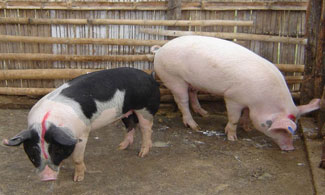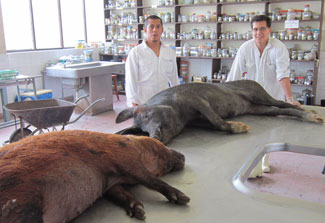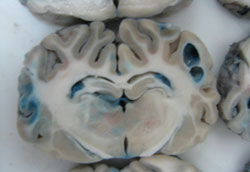Scientists work to eliminate disease carried by pigs
March / April 2015 | Volume 14, Issue 2


Photos by Miguel Marzal/Universidad Cayetano Heredia
A vaccine has proven very effective at eliminating cysticercosis
in Peruvian pigs but requires two doses.
Pigs are an important source of nutrition in many parts of the developing world but can spread a neurological disease that poses serious human health hazards. Cysticercosis is a preventable parasitic infection of the central nervous system caused by the pork tapeworm,
Taenia solium. A person can get the disease through unhygienic practices, by consuming eggs that have been excreted by someone with an intestinal tapeworm. The larval cysts can infect brain, muscle or other tissue and are a major cause of adult-onset seizures in low-income countries. People with the disease may also experience chronic headaches, depression, strokes and other problems.
Cysticercosis mainly affects rural farming communities, where poor families allow pigs to roam free to search for food that includes feces. "That's the reality in many little towns around the world," according to Dr. Hector "Hugo" Garcia, a Fogarty grantee who has spent his career studying cysticercosis. Garcia, a microbiology professor at both the Universidad Cayetano Heredia in Lima, Peru and Johns Hopkins University in Baltimore, has been leading a decade-long effort to eradicate the disease in Peru's northern coastal region of Tumbes. He is also a researcher at the National Institute of Neurology in Lima.
The research discoveries he and his team have made form the basis for the established standard of care for neurocysticercosis. Their complex, multidisciplinary studies require an understanding of epidemiology, genomics, imaging, data analysis, animal models, bioethics and clinical trials.
Since 2006, Fogarty has provided support to train more than 90 Peruvian scientists to participate in this critical work, including 25 who earned master's degrees and five who received their Ph.D.s. Garcia says that has created a solid research structure attracting funders, such as the NIH's National Institute of Allergy and Infectious Diseases (NIAID), the Wellcome Trust and the Bill and Melinda Gates Foundation, which is supporting the Tumbes eradication program.

Photo by Miguel Marzal/
Universidad Cayetano Heredia
Peruvian scientists have tested antiparasitic drugs
in pigs. The blue dye indicates disruptions in the
blood-brain barrier.
Garcia's team has studied several elimination strategies, including an effective vaccine for pigs that was developed in Australia. "We have had major successes," noted Garcia. "Demonstrating that we can wipe out the disease with focused efforts in targeted villages provides a major advance in the control and possible elimination - and perhaps eventual eradication - of this terrible disease."
But barriers remain before the intervention can be scaled up and adapted for other locations, he acknowledged. Especially challenging is the fact that the vaccine must be administered in two doses, requiring staff to catch each pig twice. "It's logistically complicated, we need to find a vaccine that works in a single dose," he said.
Garcia recently visited NIH to present his work, in a lecture sponsored by NIAID. He said although the disease was identified in the 1800s, only recently have sophisticated imaging tools allowed scientists to better understand the disease. After exposure in humans, it takes about three months for brain cysts to grow. Three to five years later, they begin to die and calcify, which is when seizures and other issues frequently develop.
Simple blood tests can determine presence of the disease, Garcia noted, but CTs or MRIs are required to see if the parasites are alive or dead. Even then, scientists are split on the best treatment. Some recommend sufficient doses of drugs to kill the parasites but others caution that can lead to harmful brain inflammation. "You have to use common sense," Garcia suggested. "In general, we think killing the parasites is beneficial."
More Information
To view Adobe PDF files,
download current, free accessible plug-ins from Adobe's website.